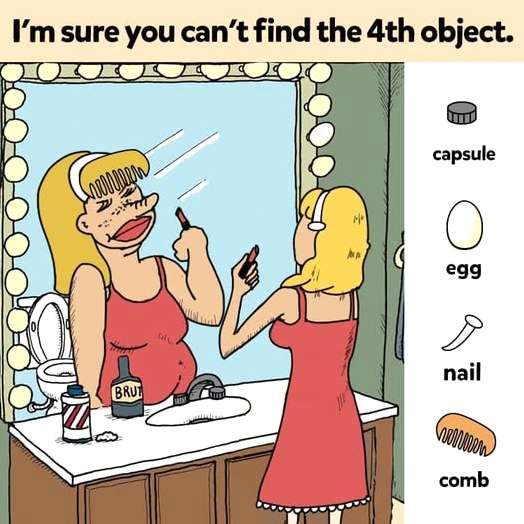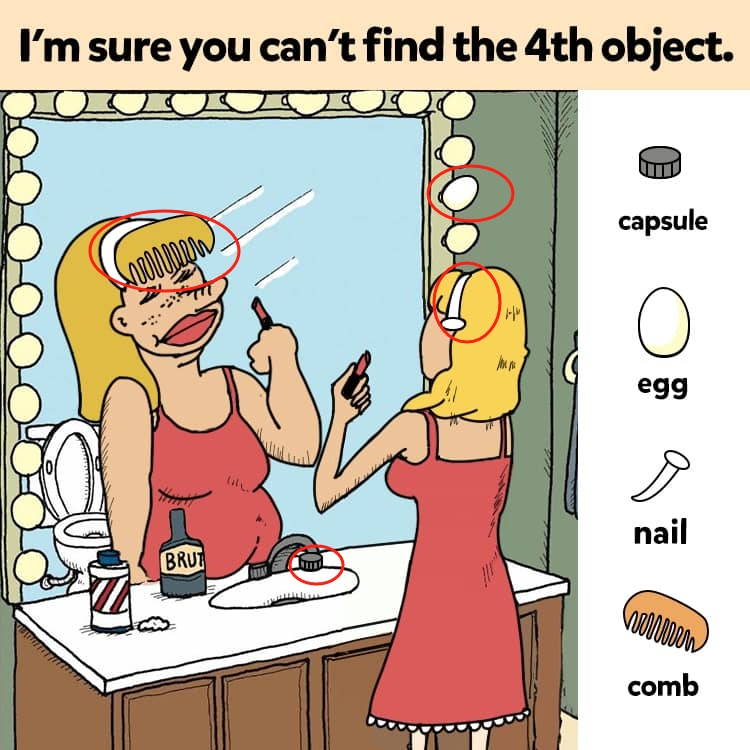Do you trust your eyes? Think you can catch what others miss? Here’s your chance to prove it.
In this deceptively simple yet surprisingly tricky observation game, you’re asked to find four specific objects: a capsule, an egg, a nail, and a comb. Easy enough, right? But here’s the twist—only three seem to pop out right away, and the fourth stays hidden, even from the sharpest eyes.
This isn’t just a game. It’s a brain workout. And you’re about to find out if you’re part of the rare 10% who can actually find all four.

The Setup: A Puzzle That Looks Too Easy
The image itself appears ordinary at first. Maybe it’s a cluttered room, a pile of tools, or a kitchen countertop. Whatever the setting, the goal is the same—spot four objects that don’t quite belong.
The capsule, the egg, and the nail often stand out after a few seconds. Their shapes are familiar, and if you focus, you can usually find them without too much trouble.
But the comb? The capsule? The fourth object? That’s where it gets interesting.
Why This Puzzle Plays Tricks on Your Brain
Our brains are wired to find patterns. When things blend in—either by color, size, or placement—our eyes just skip over them. The hidden object could be camouflaged against a background, partially obscured by another item, or even rotated to look like something else entirely.
This challenge is designed to disrupt your expectations. You’re looking for familiar objects in unfamiliar contexts. The mind wants to find what it expects to see. But sometimes, the trick lies in seeing what’s really there, not what you think should be.
The 30-Second Rule: Pressure Meets Perception
Here’s the challenge: you’ve got 30 seconds. That’s it.
In just half a minute, can you beat the odds and find all four hidden objects?
This short time frame creates pressure—your heart might race a little, your focus sharpens, and your mind starts filtering fast. But speed is a double-edged sword. The faster you search, the more likely you are to miss the subtle details.
Three Are Easy. The Fourth Will Test You.
Let’s break it down:
- Capsule – Often hidden near other small, cylindrical items. Look near bottles, cords, or in cluttered spaces.
- Egg – The smooth, round shape is easier to catch—but it might be nestled in a bowl, beside stones, or near anything oval.
- Nail – Sharp, thin, and metallic, it often blends into toolboxes or wood textures.
- Comb – The trickiest of the bunch. With thin, repetitive lines, it can vanish against striped patterns, hairbrushes, or even textures on clothing.
Most people get stuck at three. Their brain declares victory, and they move on—without ever realizing what they missed.

What Makes This Puzzle So Addictive?
This isn’t just about finding hidden objects. It’s about what it reveals about you.
Are you the type to quit when it looks done? Or do you dig deeper, double-check your assumptions, and refuse to settle for “good enough”?
These visual tests are addictive because they challenge your perception and reward persistence. They push you to slow down in a world that constantly speeds up.
The Reveal: Did You Spot All Four?
When the answer is finally revealed—usually at the bottom of the post or in a follow-up—it triggers one of two reactions:
- “Aha! I knew it!”
- Or… “Wait, THAT was it?! How did I miss that?!”
That’s the beauty of it. Simple objects, cleverly hidden. And your brain learns every time.
Why Observation Puzzles Are More Than Just Fun
Puzzles like this aren’t just social media time-wasters. They actually serve a purpose.
- They sharpen your visual processing
- They improve focus and patience
- They activate problem-solving parts of your brain
- They teach you to challenge assumptions
In today’s digital age, where attention spans are shrinking, training your mind to slow down and notice the small stuff might be the most underrated skill out there.
Final Thoughts: What You See Isn’t Always What’s There
The “Find the 4th Object” challenge is a perfect reminder that the obvious isn’t always complete. Whether you spotted all four or got stumped by that sneaky last one, the real win is taking the time to look deeper.
Next time you scroll past a puzzle like this, don’t rush. Observe. Scan. Challenge your instincts. You never know what you’re missing… until you stop to find it.




